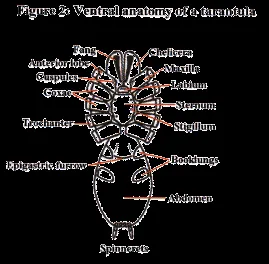The Exoskeleton Overview
The tarantula, a captivating creature, boasts a fascinating anatomy that sets it apart in the animal kingdom. Understanding the body parts of a tarantula is key to appreciating its survival strategies and unique adaptations. One of the most defining features of a tarantula is its exoskeleton, a hard, protective outer covering that provides support and defense. This rigid structure, composed primarily of chitin, acts as the spider’s skeleton, offering protection from predators and the environment. The exoskeleton is not merely a shell; it’s a complex structure crucial to the tarantula’s survival and functionality. This external framework dictates many aspects of the spider’s life, from its movement and growth to its sensory perception.
What is the Exoskeleton
The exoskeleton is a non-living structure secreted by the epidermis, the tarantula’s skin. This shell provides a strong, yet surprisingly lightweight, barrier against physical damage and dehydration. Its composition, primarily chitin, is a complex polysaccharide also found in the cell walls of fungi and the shells of other arthropods like insects and crustaceans. The exoskeleton’s structure is segmented, allowing for flexibility and movement at the joints. This segmented design is particularly noticeable in the legs, enabling a wide range of motion crucial for hunting, climbing, and navigating its environment. The exoskeleton’s surface often features various textures, colors, and patterns, which aid in camouflage and species identification.
Benefits of the Exoskeleton
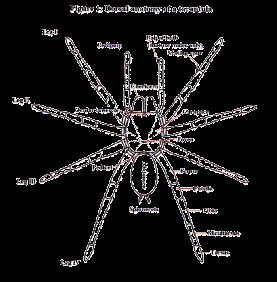
The exoskeleton offers several key benefits to the tarantula. Firstly, it provides robust protection against predators. The hard shell makes it difficult for many animals to penetrate, offering a significant defensive advantage. Secondly, it helps prevent water loss, a crucial adaptation for survival in diverse environments. The exoskeleton’s waterproof nature minimizes dehydration, a vital aspect of maintaining the tarantula’s internal balance. The exoskeleton also provides structural support, allowing the tarantula to move and maneuver effectively. The hard shell of a tarantula also offers points of attachment for muscles, facilitating movement. This structure also provides a surface for sensory hairs, essential for navigation, and prey detection.
Cephalothorax: The Head and Thorax
The cephalothorax, also known as the prosoma, is the combined head and thorax region of the tarantula. This fusion is a defining characteristic of arachnids, including spiders. The cephalothorax houses essential body parts, including the eyes, chelicerae, pedipalps, and the brain. The dorsal surface of the cephalothorax is covered by a carapace, a hardened plate that offers protection to the delicate internal organs. This area is the control center and main hub for sensory information and movement. The cephalothorax is crucial for feeding, sensing the environment, and coordinating the spider’s activities. This fusion is an evolutionary adaptation, providing efficiency and concentrated functionality, crucial for the tarantula’s survival.
Eyes of a Tarantula
Tarantulas typically have eight eyes, arranged in two rows, although the specific arrangement and visual acuity can vary between species. While their vision is not as sharp as that of some other predators, tarantulas can perceive light, shadow, and movement. This helps them to detect prey and predators, as well as navigate their surroundings. The eyes primarily function to identify movement, allowing them to distinguish between potential threats and opportunities. The arrangement and placement of the eyes provide the spider with a wide field of view. The presence of multiple eyes allows the tarantula to perceive depth and distance, which is crucial for hunting and avoiding danger in their environment.
Chelicerae and Fangs
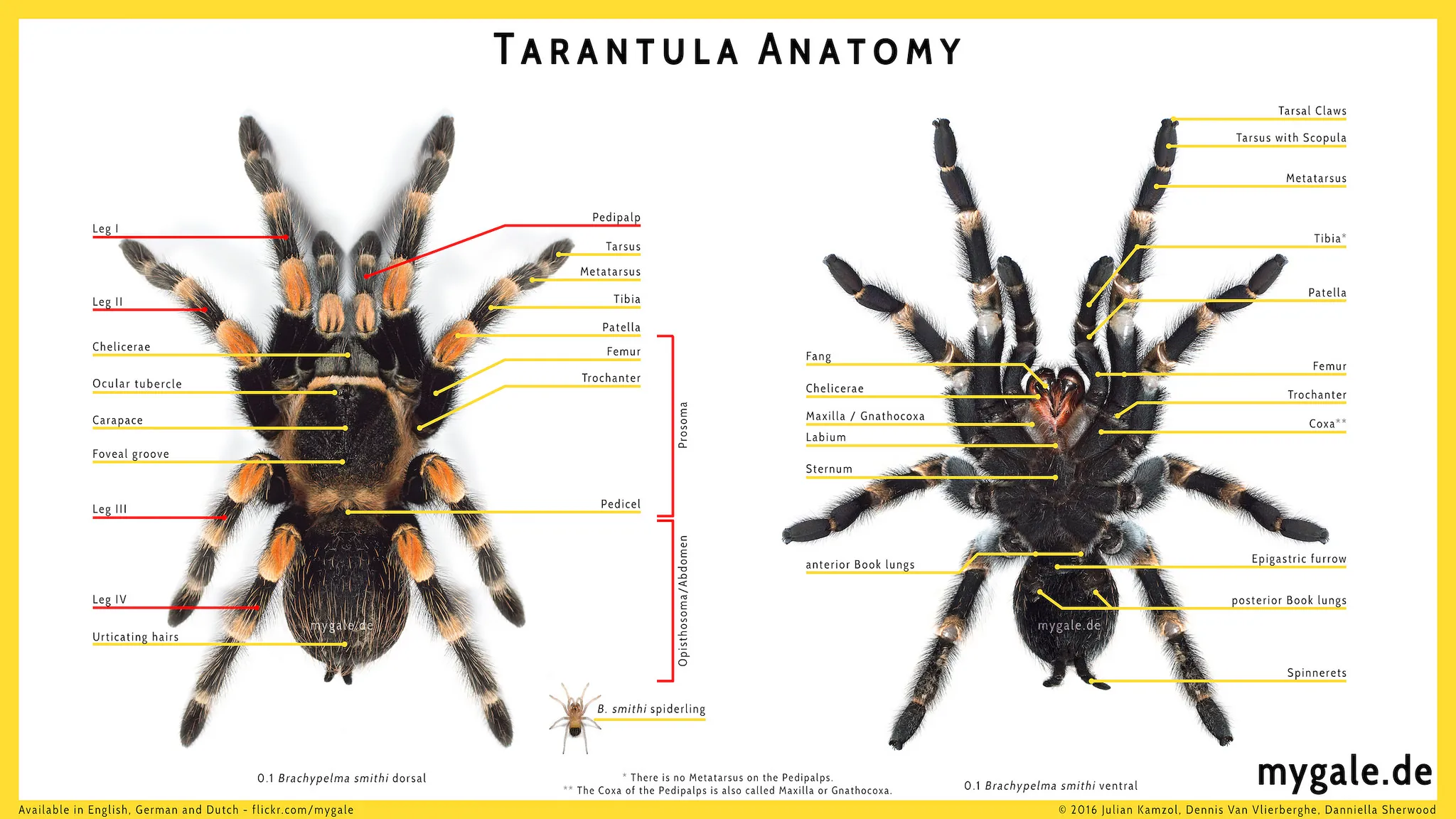
The chelicerae are a pair of appendages located in front of the tarantula’s mouth, used for grasping and crushing prey. At the end of each chelicera is a fang, or a modified claw, that injects venom into the prey. This venom paralyzes or kills the prey, allowing the tarantula to consume it. The size and shape of the chelicerae and fangs vary depending on the species, reflecting their feeding habits and prey preferences. The chelicerae are extremely powerful, and the tarantula uses them not only for feeding but also for defense. The fangs are designed to pierce the exoskeleton of insects and other prey, enabling the venom to be delivered effectively. The chelicerae and fangs play an important role in the overall survival of the spider.
Pedipalps
Pedipalps are another pair of appendages located near the mouth, used for manipulating food, sensing the environment, and in males, for mating. These appendages are often mistaken for small legs, but they serve a different purpose. The pedipalps are equipped with sensory receptors, allowing the tarantula to detect changes in its surroundings. Male tarantulas use their pedipalps to transfer sperm to the female during mating, which is a key part of their reproductive process. The pedipalps also assist in handling and consuming prey. These appendages are an essential part of the tarantula’s sensory system, allowing it to gather crucial information about its environment. The pedipalps are very important to the spider’s way of life.
The Abdomen: Where the Magic Happens
The abdomen is the posterior section of the tarantula’s body, where the digestive and reproductive organs are located. The abdomen is generally soft and flexible, allowing for expansion as the tarantula feeds and grows. The abdomen also houses vital organs, including the heart, book lungs, and silk-producing spinnerets. The size of the abdomen can vary depending on the tarantula’s diet and overall health. It plays a crucial role in the spider’s life cycle and survival. The abdomen’s flexibility allows the spider to molt, which is essential for growth. This part is also a significant factor in the tarantula’s overall health and well-being, housing essential organs for survival.
Spinnerets and Silk Production
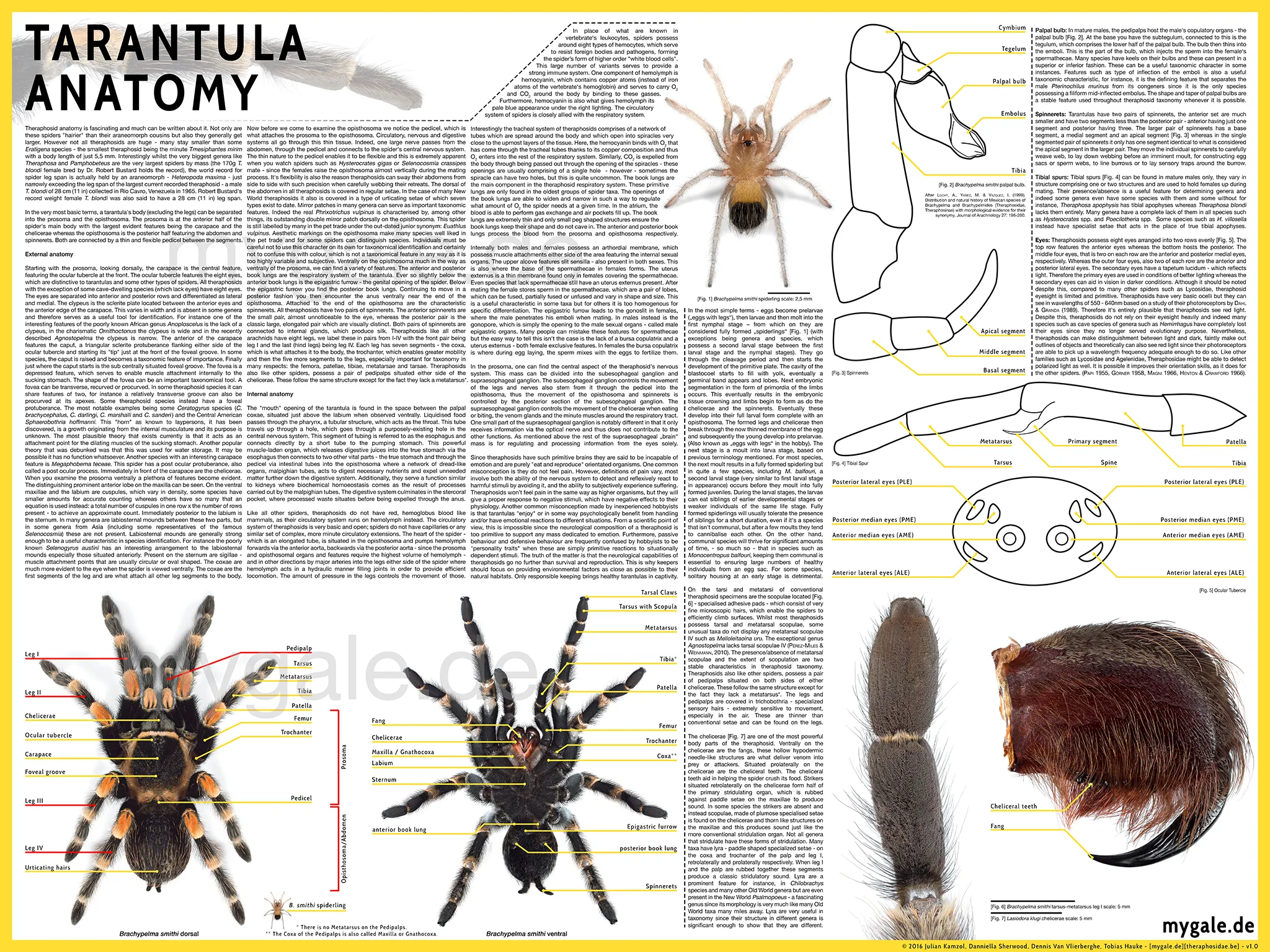
At the end of the abdomen are the spinnerets, which are used to produce silk. Silk is a versatile material, used by tarantulas for various purposes, including creating webs, constructing retreats, and wrapping prey. The number and arrangement of spinnerets vary among species. Tarantulas use silk to line their burrows, providing a safe and comfortable living space. Silk is also used to create tripwires, which alert the spider to the presence of potential prey or threats. The silk’s strength and flexibility make it an ideal material for catching and securing prey. Silk production is a crucial adaptation, allowing the tarantula to thrive in diverse environments.
Book Lungs and Respiration
Book lungs are respiratory organs found within the abdomen, used for gas exchange. These structures are named for their resemblance to the pages of a book. The book lungs consist of numerous thin, parallel lamellae, which increase the surface area for oxygen absorption. This allows the tarantula to breathe efficiently. The book lungs are an important part of the tarantula’s circulatory system. The number and size of the book lungs can vary. The book lungs are a key part of a tarantula’s respiratory system, allowing them to obtain oxygen from their surroundings. These structures are a crucial adaptation for terrestrial life, allowing the tarantula to breathe in its natural habitat.
Legs and Movement
Tarantulas have eight legs, used for walking, climbing, and sensing their environment. The legs are segmented, allowing for flexibility and a wide range of motion. The legs are covered with sensory hairs, which help the tarantula detect vibrations, air currents, and other stimuli. The legs are crucial to the tarantula’s ability to hunt, escape predators, and navigate its surroundings. The leg structure also contributes to the spider’s ability to climb. Tarantulas can move with speed and precision, making them formidable predators. The legs’ design provides a great balance between agility and stability.
Leg Structure
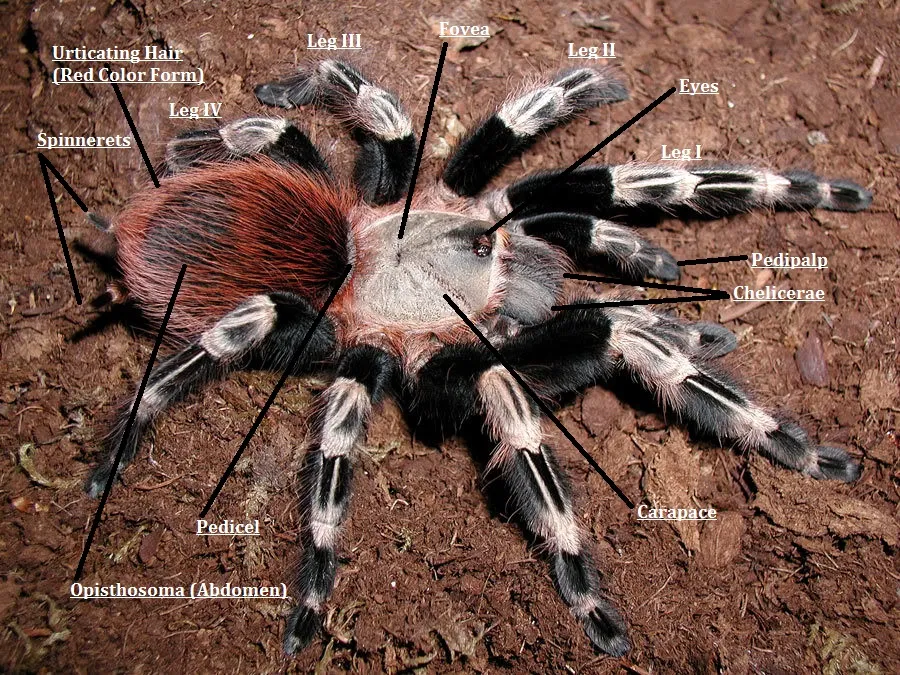
Each tarantula leg is made up of several segments, including the coxa, trochanter, femur, patella, tibia, metatarsus, and tarsus. These segments are connected by flexible joints, allowing the leg to bend and move in various directions. The structure of the legs provides the tarantula with stability and control. The last segment of the leg, the tarsus, is equipped with claws, which help the spider grip surfaces. This structure enables the tarantula to climb and walk on various surfaces. The design of the legs allows for rapid movement. The legs’ structure is crucial for the tarantula’s survival in its natural environment.
Sensory Hairs
Sensory hairs, also known as setae, cover the tarantula’s legs and body. These hairs are sensitive to touch, vibration, and air currents, providing the spider with crucial sensory information. The sensory hairs allow the tarantula to detect the presence of prey, as well as predators. They also play a role in navigation and orientation. The sensory hairs can detect subtle changes in the environment. This allows the tarantula to identify potential threats and opportunities. The sensory hairs are a key part of the spider’s sensory system, providing it with valuable information about its surroundings. These sensory hairs are an essential part of the tarantula’s survival strategy.
Molting and Growth
Tarantulas, like all arthropods, must molt to grow. Molting is the process of shedding the old exoskeleton and growing a new one. This process is essential for the tarantula to increase in size. The frequency of molting varies depending on the age of the spider, with younger tarantulas molting more often than adults. Molting is a vulnerable time for the tarantula, as it is soft and defenseless during this period. Molting is a fundamental part of their life cycle, permitting growth and development. Molting is a key aspect of the spider’s biology, enabling it to grow and adapt to its environment.
The Molting Process
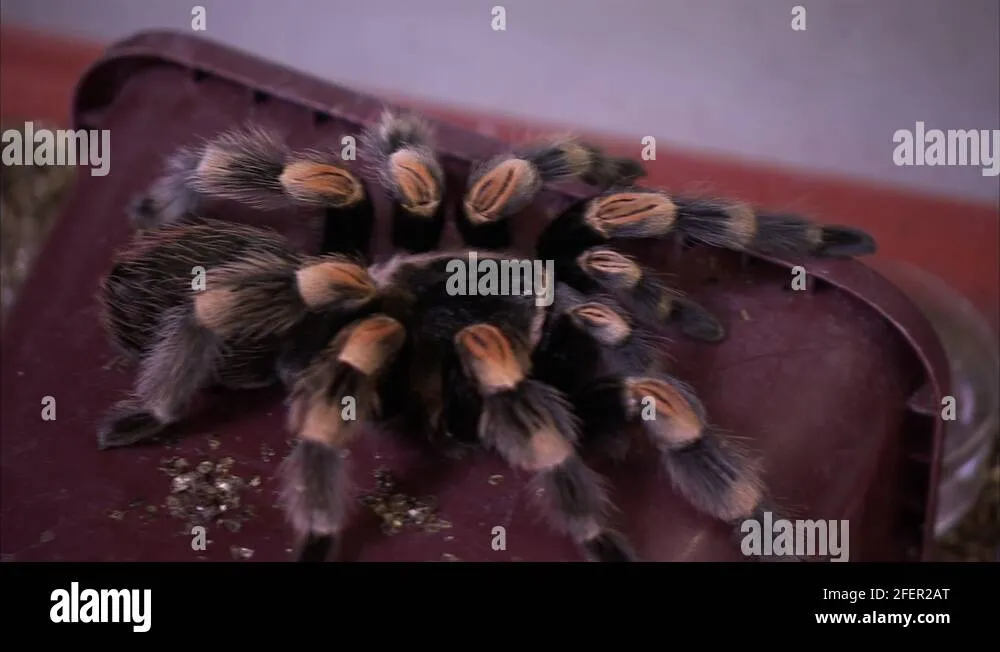
Before molting, the tarantula stops eating and prepares for the process. The tarantula absorbs the old exoskeleton, which makes it easier to shed. Once the process begins, the tarantula positions itself, usually on its back, and starts to split the exoskeleton, typically along the cephalothorax or abdomen. The spider then wriggles out of the old exoskeleton, revealing a new, larger one. The new exoskeleton is soft and pliable at first, gradually hardening over time. The molting process is a significant event in the tarantula’s life, allowing it to grow and renew itself. After molting, the tarantula will be more colorful and vibrant.
